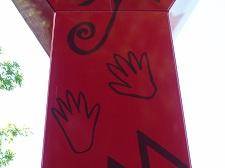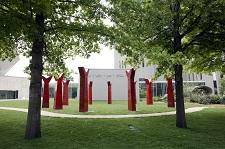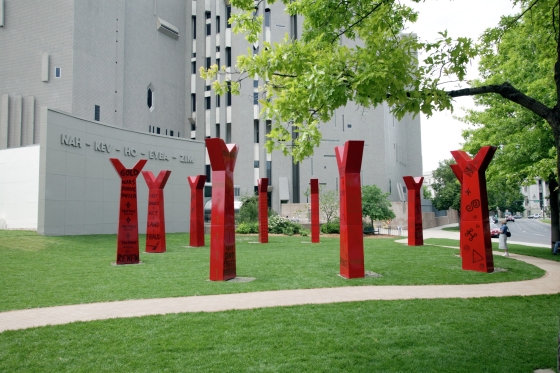Students will research issues of conflict in the past or present. After learning about both sides of an issue, they will and take a stand and make a case for their argument.
Students will be able to:
- research an area of conflict and identify both sides;
- develop a thesis statement;
- identify supporting details and evidence for an argument; and
- develop a speech or letter in which they a stand and make a case for something important to them.
Lesson
Day 1
- Show students Wheel. Explain that Edgar Heap of Birds is a member of the Cheyenne and Arapaho American Indian tribes. Ask students to describe what they see. Point out that this is a monumental sculpture in front of the Denver Art Museum’s North Building. Notice that there are ten structures, or trees. It might be hard to tell, but if you look closely you can see that there are three different types of tree tops. Ask students if the sculpture reminds of them of anything else they have seen. The trees are aligned with the sunrise of the summer solstice. Much of Edgar Heap of Birds’s artwork, including Wheel, is about refocusing how American Indian culture and history is viewed, perceived, and understood, and promotes global cooperation among indigenous peoples.
- This sculpture was made specifically for this DAM site, and the curve of the museum wall was an important part of Heap of Birds’s design. On it he placed the Cheyenne words “nah-kev-ho-eyea-zim,” which mean, “we are always returning back home again.”
- Share with students information from About the Art, pointing out the specific details in the “Details” section. Note that each tree pillar is covered with words and symbols that tell of different events in the history of American Indian peoples in Colorado and the surrounding region.
- Ask students to research conflicts that have happened in your area in the past or that are happening currently. Have them take notes for future reference by creating a chart of their findings.
- After students have researched both sides of the issue, ask them to make a decision about which side they agree with.
Day 2
- Instruct students to write a persuasive letter or speech about the issue. Remind them to state their position, or thesis. They should also explain their desired outcome or what they what their audience to do about the issue. Students should explain why they feel the way they do and support their position with strong evidence. Encourage them to include emotional information for a greater impact. Finally, they should offer a strong conclusion to their letter or speech.
Day 3
- Have students share their letters with the class.
- Perhaps older students, or students who feel strongly about their issue and have parental support to do so, could send their letter to the editor of a local newspaper, or they could give their speech at a city council meeting or other venue appropriate to their issue.
Materials
- Paper and writing implements or access to a word processor
- Access to the Internet or a library for research
- Copies of the About the Art section on Wheel
- Color copies of Wheel for students to share, or the ability to project the image onto a wall or screen
Standards
- Social Studies
- History
- Understand the concept that the power of ideas is significant throughout history
- Analyze the concepts of continuity and change and effect
- Analyze the concept of complexity, unity and diversity
- Become familiar with United States historical eras, groups, individuals and themes
- Visual Arts
- Observe and Learn to Comprehend
- Relate and Connect to Transfer
- Language Arts
- Oral Expression and Listening
- Research and Reasoning
- Writing and Composition
- Reading for All Purposes
- Collaboration
- Critical Thinking & Reasoning
- Information Literacy
- Invention
- Self-Direction
Wheel
- HOCK E AYE VI Edgar Heap of Birds, Cheyenne, Arapaho, American, 1954-
- Born: Wichita, KS
- Work Locations: United States
Edgar Heap of Birds is an accomplished Cheyenne-Arapaho artist who works in a variety of media—drawing, painting, printmaking—and is known for his public art interventions and installations, including Wheel. Much of his artwork is about refocusing how American Indian culture and history is viewed, perceived, and understood.
Born in 1954, Heap of Birds holds a Bachelor of Fine Arts (BFA) from the University of Kansas and a Masters of Fine Arts (MFA) from Tyler School of Art (Temple University, Philadelphia). He also did graduate work at the Royal College of Art in London. He is on the faculty of Oklahoma University with a joint appointment in Native American Studies and Fine Arts.
Wheel was created specifically for its site at the Denver Art Museum and is rich in symbolism. Several American Indian artists were invited to submit proposals for a major public artwork to be located next to the museum’s North Building entrance. Use of the building’s curved wall was a key factor in Heap of Birds’s proposal—on it, in raised letters, he placed the Cheyenne words “nah-kev-ho-eyea-zim,” which mean “we are always returning back home again.”
Heap of Birds wants Wheel to be a gathering place for the community. The circle form is based on the Big Horn Medicine Wheel, a sacred site in northern Wyoming, as well as the circular form of a traditional Plains Indian Sun Dance lodge. The ten forked poles, or trees, are aligned with the summer solstice—on June 21st, the sun rises in an opening to the east between the first and last poles. Each tree is covered with words and drawings that recount different events in the history of American Indian peoples in Colorado and the surrounding region, from conflict over resources to global cooperation among indigenous peoples.
Details

Imagery
Bison hoof prints and outlines of hands are among the many sketches of actual objects that Heap of Birds included on the poles, along with graphic design elements like the double spiral taken from ancestral Puebloan cultures.

Magpies
While most of the imagery on the trees refers to historical events, some is specific to Heaps of Birds and his family. On the tenth tree, the magpies flying upward represent the name “Heap of Birds.”

Words as Image
Although words are used literally as text that describes historic events, they also serve as design elements. Heap of Birds chose varied styles of lettering to add mood and visual interest.

Tree Forms
Heap of Birds used three styles of forked tree forms in Wheel, inspired in part by a tree that once stood at the site. The forms also refer to the forked poles that hold up a Sun Dance lodge. The artist’s original drawings show twelve trees in the circle, but the final artwork has only ten. According to Heap of Birds, Wheel is his creative expression, and he omitted two poles so that it would not be read as religious.
Funding for object education resources provided by a grant from the Morgridge Family Foundation. Additional funding provided by the William Randolph Hearst Endowment for Education Programs, and Xcel Energy Foundation. We thank our colleagues at the University of Denver Morgridge College of Education.
The images on this page are intended for classroom use only and may not be reproduced for other reasons without the permission of the Denver Art Museum. This object may not currently be on display at the museum.







